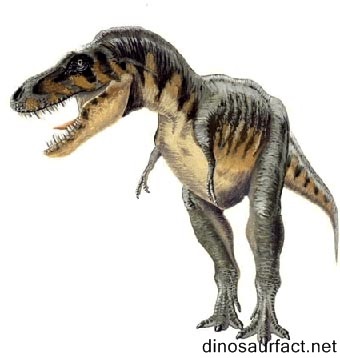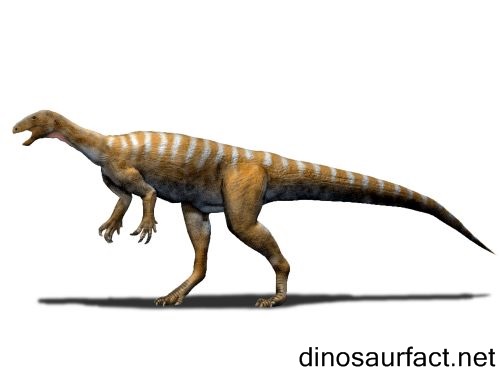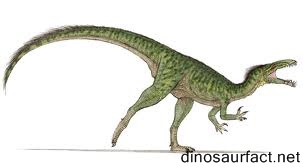 |
|
 |
|
Kingdom: Animalia
Phylum: Chordata
Class: Sauropsida
Superorder: Dinosauria
Order: Saurischia
Suborder: Sauropodomorpha
Genus: Agrosaurus
 |
|
 |
|
 |
|

Agrosaurus is the name given to the remaining parts of what was initially accepted to be a Triassic prosauropod from Australia. Agrosaurus would accordingly be the most seasoned dinosaur from that nation. In any case, this seems to have been a blunder, and the material really seems to originate from a Thecodontosaurus or a species closely related to the Thecodontosaurus. The sort species is Agrosaurus macgillivrayi.
Discovered by Chance
The name Agrosaurus was given to a Triassic prosauropod that was at the time considered to be from Australia, thus making it the oldest dinosaur ever discovered from the continent. Therein lies the comedy of errors and controversy surrounding it ever since.
The name Agrosaurus is derived from the Greek word 'agros' which means 'field' and 'sauros' which means 'lizard'. It refers to the natural habitat where it was supposedly discovered which was in NE Queensland, Australia.
The real drama surrounding the description of the dinosaur was played out much later in faraway Europe. There was a discovery of a few limb bones, a claw, and a tail vertebrae. They were transported to the Natural History Museum in London tagged "HMS Fly". In 1891, a lead prominent anthrophologist named Jn. Macgillivray and Harry Govier Seeley where to publish a description of a prosauropod dinosaur. The fossils, which were supposedly discovered off the NE coast of Australia, were named Agrosaurus macgillivrayi by Seeley.
Legendary naturalist, John Macgillivray, was part of the 1844 British expedition of four-ship quartet spearheaded by the HMS Fly. He travelled to the Cape York Peninsular in Queensland to construct a beacon on Raine Island. In the next four and a half months they continued the construction of the beacon while the ship crew extensively explored the eastern side of Cape York Peninsular, north up to Cape Grenville.
Edward Smith Stanley, the 13th Earl of Derby, had entrusted John Macgillivray with the task of collecting animal specimens. Unfortunately John Macgillivray's notes were lost and furthermore he did not mention about collecting any animal fossils in a book written by him a few years later during a similar expedition to the area.
The geologist J. Bette Jukes published a book in 1847 about the 1844 expedition and even he did not mention about any fossils being collected by Macgillivray or his crew either.
What is established from the few fossils ever recovered is the fact that the living animal was probably around three meters (10 feet) long while its appearance was like a typical prosauropodan - long neck with a small head, a bulky body and clawed feet.
As was common with other prosauropods, it was probably more comfortable on all four limbs but was also quite capable of moving around on its hind legs, which were elongated. The possibility is that it was either a herbivore or an omnivore.
Controveries and aftermath
In 1995 there was considerable agreement over where exactly this Australian dinosaur was found. A group of 10 paleontologists and volunteers set about to search the Captain Billy Landing where the HMS Fly was know to have harbored.
Previously, reconnaissance flights in 1993 had indicated Mesozoic age rock presence in the same area of the original agrosaurus discovery area. It was hoped that this may lead to further discoveries and possible conclusive proof.
After four days of extensive search, the surface proved a lack of fossils. A more detailed search of the Captain Billy Landing was conducted and this yielded two scaps of what may have been fossil bone. Further intensive search yielded no further fossil material from the area.
Later analysis proved that what was suspected to be fossil bone was indeed so but it was very different from all the other Agrosaurus material. While the spongiosa of the Agrosaurus were open, the new samples were solid and its internal spaces were filled minerals.
Von Huene, in 1906, stated that the rock matrix from which the Agrosaurus fossil had been prepared was full of fragments. It was consistent with bone fragments excavated at Durdham Downs, a place near Bristol, England. It indicated that the bone fragments might belong to an sphenodontian called Diphyodontosaurus avonis, which was commonly found in that part of England in the Triassic age.
Furthermore, the presences of seven trace elements were compared among the samples of the Agrosaurus material. There were samples from Durdham Downs and the two bone fragments from Cape York, Australia. Tests confirmed that the Agrosaurus material compared more likely with samples from Durdham Downs than the two bone fragments collected from Cape York. All the evidence suddenly suggested that Australia's oldest dinosaur may not be Australian after all
Transitional features
From the meager remains the living creature would seem to have been around three meters in length (10ft), with a commonly prosauropodan appearance, massive body, long neck, little head, and pawed feet. Like different prosauropods, it was presumably similarly agreeable on all fours and also on its stretched rear legs. It was herbivorous but possibly may have been an omnivore.
The name Agrosaurus is currently for the most part thought to be a nomen dubium or a lesser equivalent word of Thecodontosaurus. In the event that Agrosaurus is not from Australia, which appears to be most likely, Rhoetosaurus and Ozraptor, both from the Bajocian (Middle Jurassic) would be the most established known Australian dinosaurs. Luckily they are decently reported.
Location
It was not until the 1980s and 1990s that huge quantities of dinosaurs started to be unearthed from Australia. These primarily originated from an unearthing at Dinosaur Cove in Victoria and Lightning Ridge in New South Wales. The majority of these fossils are from dinosaurs that are new to science regardless are constantly concentrated on.
Index
Extinct Profiles
 Triassic Dinosaurs
Triassic Dinosaurs Jurassic Dinosaurs
Jurassic Dinosaurs Cretaceous Dinosaurs
Cretaceous Dinosaurs Pterosaurs
Pterosaurs Marine Reptiles
Marine Reptiles Dinosaur Extinction
Dinosaur Extinction